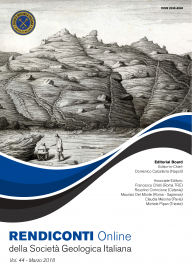
Cartografia geologica del confine calabro-lucano alla fine del XIX secolo: il contributo di Giovanni Battista Bruno, "amatore di geologia"
Paolo Perini
Servizio Geologico d'Italia, ISPRA, Via V. Brancati 48, 00144 Roma.
Corresponding author e-mail: paolo.perini@isprambiente.it.
Volume: 44/2018
Pages: 45-50
Abstract
The Universal Exhibition in 1878 was held in Paris and three years later Bologna hosted the 2nd International Geological Congress.
In occasion of those events, the priority of the Regio Ufficio Geologico d'Italia (Geological Survey of Italy) was the completion of small scale geological maps. It was clear that there were many gaps in the geological knowledge of large areas, especially in the Southern part of the peninsula, and it was therefore necessary to collect all available geological data. In the historical Archive of Geological Survey of Italy - ISPRA, two unpublished documents by Giovanni Battista Bruno, engineer of the Corpo Reale del Genio Civile (Royal Corps of Civil Engineers), which provided a helpful contribution
in achieving that goals. The most important is a geological map at 1:114,000 scale, exhibited in Paris, acompanied by a table of geological sections and supported by a manuscript dated 1878. The historical value of this documents is significant because, despite interpretation results were largely superseded by later studies, they provided field data that were innovative with respect to state of the art in such historical period. The rediscovery of these documents provides new elements about the history of geological interpretation of the Southern Apennines.
Keywords
Get Full Text